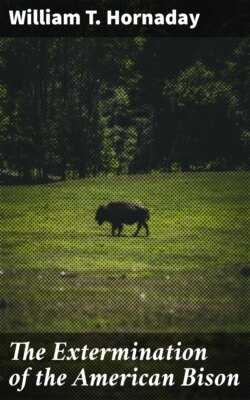The Extermination of the American Bison

Реклама. ООО «ЛитРес», ИНН: 7719571260.
Оглавление
William T. Hornaday. The Extermination of the American Bison
The Extermination of the American Bison
Table of Contents
Group of American Bisons in the National Museum. Collected and mounted by W. T. Hornaday. MAPS
PREFATORY NOTE
THE EXTERMINATION OF THE AMERICAN BISON,
By William T. Hornaday, Superintendent of the National Zoological Park
PART I.—LIFE HISTORY OF THE BISON
I. Discovery of the species
II. Geographical Distribution
Head of Buffalo Bull. From specimen in the National Museum Group. Reproduced from the Cosmopolitan Magazine, by permission of the publishers
III. Abundance
Slaughter of Buffalo on the Kansas Pacific Railroad. Reproduced from “The Plains of the Great West,” by permission of the author, Col. R. I. Dodge
IV. Character of the species
From photograph of group in National Museum. Engraved by R. H. Carson. Buffalo Cow, Calf (Four Months Old), and Yearling. Reproduced from the Cosmopolitan Magazine, by permission of the publishers
BISON AMERICANUS. (Male yearling, taken Oct. 31, 1886. Montana.) (No. 15694, National Museum collection.)
BISON AMERICANUS (“Spike” bull, two years old; taken October 14, 1886. Montana.) (No. 15685, National Museum collection.)
Spike Bull. From the group in the National Museum. Reproduced from the Cosmopolitan Magazine, by permission of the publishers
Bull Buffalo in National Museum Group. Drawn by Ernest E. Thompson
BISON AMERICANUS (Male, eleven years old. Taken December 6, 1866. Montana.) (No. 15703, National Museum collection.)
BISON AMERICANUS (Young cow, in third year. Taken October 14, 1886. Montana.) (No. 15686, National Museum collection.)
From a photograph. Engraved by Frederick Juengling. Bull Buffalo. (Rear View.) Reproduced from the Cosmopolitan Magazine, by permission of the publishers
BISON AMERICANUS (Adult cow, eight years old. Taken November 18, 1886. Montana.) (No. 15767, National Museum collection.)
V. The Habits of the Buffalo
Development of the Horns of the American Bison. 1. The Calf. 2. The Yearling. 3. Spike Bull, 2 years old. 4. Spike Bull, 3 years old. 5. Bull, 4 years old. 6. Bull, 11 years old. 7. Old "stub-horn" Bull, 20 years old
VI. The Food of the Bison
VII. Mental Capacity and Disposition
VIII. Value of the Buffalo to MAN
Memorandum of buffalo robes and hides bought by Messrs J. & A. Boskowitz, 101-105 Greene Street, New York, and 202 Lake street, Chicago, from 1876 to 1884
Total number of buffalo skins handled in nine years, 246,175; total cost, $924,790
UTILIZATION OF THE BUFFALO BY WHITE MEN
Fig. 1. A Dead Bull. From a photograph by L. A. Huffman
Fig. 2. Buffalo Skinners at Work. From a photograph by L. A. Huffman
Fig. 1. Five Minutes’ Work. Photographed by L. A. Huffman
Fig. 2. Scene on the Northern Buffalo Range. Photographed by L. A. Huffman
IX. The Present Value of the Bison to Cattle-Growers
Half-breed (Buffalo-Domestic) Calf.—Herd of C. J. Jones, Garden City, Kansas. Drawn by Ernest E. Thompson
Half-breed (Buffalo-Domestic) Cow.—Herd of C. J. Jones, Garden City, Kansas. Drawn by Ernest E. Thompson
Young Half-breed (Buffalo-Domestic) Bull.—Herd of C. J. Jones, Garden City, Kansas. Drawn by Ernest E. Thompson
Statistics of full-blood buffaloes in captivity January 1, 1889
PART II.—THE EXTERMINATION
I. Causes of the Extermination
II. Methods of Slaughter
Still-hunting Buffaloes on the Northern Range. From a painting by J. H. Moser, in the National Museum
The Chase on Horseback. From a painting in the National Museum by George Catlin
Number of carts assembled for the first trip
Cree Indians Impounding Buffaloes. Reproduced from Prof. H. Y. Hind’s—“Red River, Assinniboine and Saskatchewan Expedition.”
The Surround. From a painting in the National Museum by George Catlin
III. Progress of the Extermination
A. The Period of Desultory Destruction, from 1730 to 1830
Indians on Snow-shoes Hunting Buffaloes. From a painting in the National Museum by George Catlin
B. The Period of Systematic Slaughter, from 1830 to 1838
Buffalo product
Southern buffaloes slaughtered by southern Indians
The slaughter of the southern herd
Where the Millions Have Gone. From a painting by J. H. Moser in the National Museum
IV. Congressional Legislation for the Protection of the Bison
V. Completeness of the Extermination
VI. Effects of the Extermination
VII. Preservation of the Species from Absolute Extinction
PART III.—THE SMITHSONIAN EXPEDITION FOR MUSEUM SPECIMENS
I. The Exploration
II. The Hunt
Sketch Map of the Hunt for Buffalo. Montana 1886
Trophies of the Hunt. Mounted by the author in the U. S. National Museum. Reproduced from the Cosmopolitan Magazine, by permission of the publishers
III. The Mounted Group in the National Museum
THE ACCESSORIES
THE SIX BUFFALOES
THE TAXIDERMIST’S OBJECT LESSONS
Map Illustrating the Extermination of the American Bison. Prepared by W. T. Hornaday. Footnote
INDEX
Отрывок из книги
William T. Hornaday
Published by Good Press, 2022
.....
While it is inexpedient to include here all the facts that might be recorded with reference to the discovery, existence, and ultimate extinction of the bison in the various portions of its former habitat, it is yet worth while to sketch briefly the extreme limits of its range. In doing this, our starting point will be the Atlantic slope east of the Alleghanies, and the reader will do well to refer to the large map.
DISTRICT OF COLUMBIA.—There is no indisputable evidence that the bison ever inhabited this precise locality, but it is probable that it did. In 1612 Captain Argoll sailed up the “Pembrook River” to the head of navigation (Mr. Allen believes this was the James River, and not the Potomac) and marched inland a few miles, where he discovered buffaloes, some of which were killed by his Indian guides. If this river was the Potomac, and most authorities believe that it was, the buffaloes seen by Captain Argoll might easily have been in what is now the District of Columbia.
.....